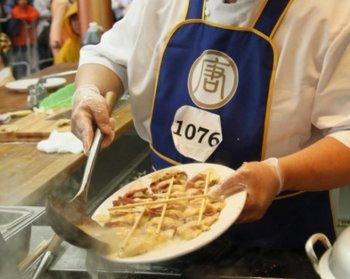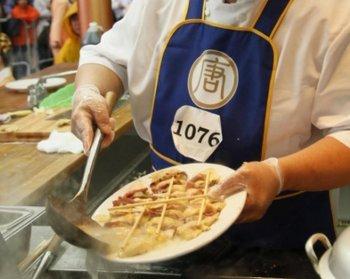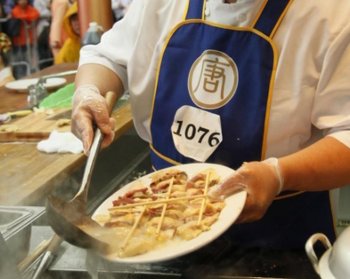NEW YORK–Right in the heart of New York’s bustling commotion in Times Square, the sounds of cars honking and falling rain was accompanied by something else rarely heard on the streets of New York—the rhythm of cleavers chopping away ferociously on the chopping block.
Sandwiched between gargantuan Broadway musical billboards and blinding LED screens, on Friday Oct. 3, NTDTV’s 3rd Annual International Chinese Culinary Competition transformed New York’s most iconic destination into a scene straight from the ancient Tang dynasty capital of Chang’an.
Contestants cooked their dishes in five cooking stations specially designed for the occasion. The stations, complete with classic ceramic roofs and high BTU units to fire up iron woks, was truly an amazing feat of design and engineering. Men and women clad in traditional clothing served the dishes to the panel of judges and the VIP patrons. Finished dishes were carried from the cooking stations to the judges in portable wooden tables used in antiquity for preparing the emperor’s meals when he went hunting.
At the sound of the gong, 35 master chefs from around the globe started work in the final rounds on Friday. Seventeen of them survived the first round of elimination at the preliminaries held on Thursday, while the other 18 passed the preliminaries for the Asia-Pacific region held earlier this year in Taiwan.
NTDTV, an independent Chinese language television network with a mission to revive traditional Chinese culture through their Global Competition Series, required its contestants to use traditional Chinese cooking techniques and ingredients to cook dishes from five regional cuisines of China: Szechuan, Shandong, Cantonese, Huaiyang, and Northeastern.
Szechuan cuisine specializes in the spicy, with over 9 different varieties of spiciness in its stock of over 20 basic flavors, the most out of the 5 cuisines, according to the competition’s website. The peppercorn is often used in dishes to leave a sensation of numbing hotness on the eater’s tongue.
Sandwiched between gargantuan Broadway musical billboards and blinding LED screens, on Friday Oct. 3, NTDTV’s 3rd Annual International Chinese Culinary Competition transformed New York’s most iconic destination into a scene straight from the ancient Tang dynasty capital of Chang’an.
Contestants cooked their dishes in five cooking stations specially designed for the occasion. The stations, complete with classic ceramic roofs and high BTU units to fire up iron woks, was truly an amazing feat of design and engineering. Men and women clad in traditional clothing served the dishes to the panel of judges and the VIP patrons. Finished dishes were carried from the cooking stations to the judges in portable wooden tables used in antiquity for preparing the emperor’s meals when he went hunting.
At the sound of the gong, 35 master chefs from around the globe started work in the final rounds on Friday. Seventeen of them survived the first round of elimination at the preliminaries held on Thursday, while the other 18 passed the preliminaries for the Asia-Pacific region held earlier this year in Taiwan.
Five Distinctive Cuisines
NTDTV, an independent Chinese language television network with a mission to revive traditional Chinese culture through their Global Competition Series, required its contestants to use traditional Chinese cooking techniques and ingredients to cook dishes from five regional cuisines of China: Szechuan, Shandong, Cantonese, Huaiyang, and Northeastern.
Szechuan cuisine specializes in the spicy, with over 9 different varieties of spiciness in its stock of over 20 basic flavors, the most out of the 5 cuisines, according to the competition’s website. The peppercorn is often used in dishes to leave a sensation of numbing hotness on the eater’s tongue.







